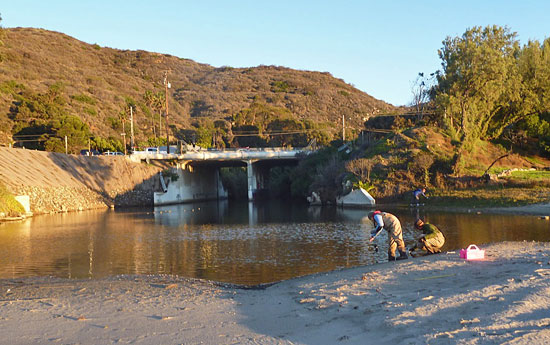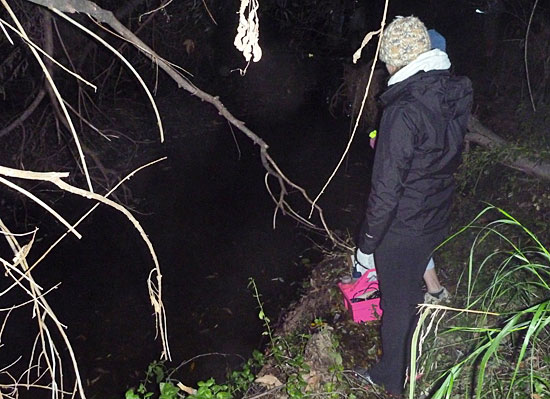Solving the whodunit of Topanga Beach
January 8, 2013

Scientists from UCLA and Santa Monica Mountains Resource Conservation District take samples from the Topanga Lagoon. Photo/Rosi Dagit
It has been a mystery now for almost a decade: What’s polluting the water at Topanga State Beach?
Once regarded as one of the cleanest stretches of ocean in Los Angeles County, Topanga fell from grace around 2003, when high bacteria levels sank its water quality score on Heal the Bay’s annual Beach Report Card.
Although cleanup efforts were diligent, testing methods couldn’t pinpoint the source of the problem. Theories abounded. Was it someone’s leaky septic system? Birds and coyotes? Illegal dumping upstream in Topanga Creek?
“We thought it might be the old septic system at the public restrooms,” says Rosi Dagit, senior conservation biologist for the Santa Monica Mountains Resource Conservation District. “So that was redone and replaced with a state-of-the-art system. Then we thought it might be the old septic systems in the rodeo grounds upstream from the lagoon, so those were removed, too.”
But the problem remained. “We kept taking out potential sources of bacteria,” Dagit says, “and the beach kept getting these high numbers.” Consequently, even though other types of pollution are markedly low at Topanga, the beach has been more or less a regular on Heal the Bay’s official “Beach Bummers” 10-worst-beaches list.
Now Topanga Beach has become the focus of an in-depth study that will seek to finally nail down the reason behind the chronically high levels of total coliform, fecal coliform and enterococcus bacteria, which may make swimmers sick.
Piggybacking on a larger statewide look at beach pollution hotspots that began in 2010, the new, two-year look at Topanga, which began in November, will sample water up to twice monthly from as many as 10 locations on Topanga State Beach and along the lower section of the creek that feeds the lagoon there. The samples then will be subjected to rigorous DNA testing.
The study also will examine the connection between tiny invertebrates and nutrient levels in the water, along with why the generally normal bacteria levels in the creek tend to spike when the water hits the lagoon and ocean, says Dagit. There’ll also be an educational component, with opportunities for school children to visit the testing labs at UCLA and learn how to help keep Southern California’s water clean.
The added scrutiny—expected to cost $550,000 during the study’s two years—is being funded through an allocation from the office of Los Angeles County Supervisor Zev Yaroslavsky. The Topanga effort is being jointly overseen by UCLA, which is a local lead on the statewide study, and the Resource Conservation District. Dagit, the county’s point-person on the project, says the tests are complex and relatively new.
“You have to collect the samples before sunlight hits the water,” she says, “because the sun makes bacteria go crazy. So we’ve been getting up at night and going down to the water before sun-up. Our last sampling was December 19, and let me tell you, it was cold.”
The tests also are expensive—about $200 per half-gallon water sample—but have come down markedly in cost over the past few years.
Scientists are enthusiastic about the study’s prospects.
“It’s like DNA fingerprinting of bacteria,” says Dagit. “We’ll be able to find out not only whether the source is human or non-human, but if it’s non-human, whether it’s from gulls, dogs, coyotes or horses and whether it came from a direct deposit on the beach, or from gray water or a septic system.”
That’s important, she says, because bacteria from a natural source, such as wildlife, requires a different set of solutions than does bacteria from the feces of pets and humans. “Suppose those bacteria levels are because of a lot of gulls roosting at Topanga Lagoon,” Dagit says. “We don’t want people swimming in water with high bacterial levels, but we don’t want to get rid of the gulls.”
Dagit says that, by this time next year, scientists should have many more clues to the mystery at Topanga Beach.
“It should be pretty amazing,” she says. “We haven’t really had the technology to do this kind of study until now.”

UCLA grad student Amy Zimmer-Faust and Senior Conservation Biologist Rosi Dagit collect bacteria samples by night in Topanga Creek. Photo/Tim Riedel
Posted 1/2/13












 405 bridge work causes a stink
405 bridge work causes a stink
